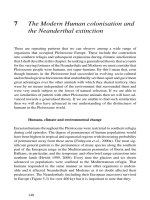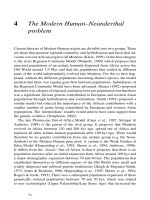The modern firm
Bạn đang xem bản rút gọn của tài liệu. Xem và tải ngay bản đầy đủ của tài liệu tại đây (1.11 MB, 335 trang )
The Modern Firm
This page intentionally left blank
The Modern
Firm
Organizational Design for
Performance and Growth
John Roberts
1
3
Great Clarendon Street, Oxford OX2 6DP
Oxford University Press is a department of the University of Oxford.
It furthers the University’s objective of excellence in research, scholarship,
and education by publishing worldwide in
Oxford New York
Auckland Bangkok Buenos Aires Cape Town Chennai
Dar es Salaam Delhi Hong Kong Istanbul Karachi Kolkata
Kuala Lumpur Madrid Melbourne Mexico City Mumbai Nairobi
São Paulo Shanghai Taipei Tokyo Toronto
Oxford is a registered trade mark of Oxford University Press
in the UK and in certain other countries
Published in the United States
by Oxford University Press Inc., New York
© Donald John Roberts 2004
The moral rights of the author have been asserted
Database right Oxford University Press (maker)
First published 2004
First published in paperback 2007
All rights reserved. No part of this publication may be reproduced,
stored in a retrieval system, or transmitted, in any form or by any means,
without the prior permission in writing of Oxford University Press,
or as expressly permitted by law, or under terms agreed with the appropriate
reprographics rights organization. Enquiries concerning reproduction
outside the scope of the above should be sent to the Rights Department,
Oxford University Press, at the address above
You must not circulate this book in any other binding or cover
and you must impose this same condition on any acquirer
British Library Cataloguing in Publication Data
Data available
Library of Congress Cataloging in Publication Data
Data available
Typeset by SPI Publisher Services, Pondicherry, India
Printed in Great Britain
by
Clays Ltd., St. Ives plc
ISBN 978–0–19–829376–7 (Hbk.)
978–0–19–829375–0 (Pbk.)
1 3 5 7 9 10 8 6 4 2
To Kathy
This page intentionally left blank
Contents
Preface
ix
Preface to the Paperback Edition
xiii
1. Strategy and Organization
1
2. Key Concepts for Organization
Design
32
3. The Nature and Purpose of the
Firm
74
4. Motivation in the Modern Firm
118
5. Organizing for Performance
180
6. Organizing for Growth and Innovation
243
7. Creating the Modern Firm:
Management and Leadership
Challenges
281
References
289
Index
303
vii
This page intentionally left blank
Preface
The most fundamental responsibilities of general managers are setting strategy and designing the organization
to implement it. Over the last decades the great value of
economics for the study of strategy and the practice of
strategizing has become evident. This book attempts to
show how economics can contribute in a similar way and
at a similar level to organizational design.
I hope that practicing managers will read and benefit
from this book. It is not, however, a “how to” book offering the final, simple answer about how to succeed.
Instead, it offers ways to think about the problem of
designing business organizations for performance and
growth. Both students of organizations and management
and practicing managers can benefit from having an
understanding of the basic principles of the economics of
organization and its application to business enterprises.
The book tries to offer this. It mixes case studies and
shorter examples with fundamental conceptual and theoretical material that is developed and presented in a nontechnical manner and then applied to the design problem.
It also seeks to explain some of the very great changes in
ix
Preface
actual companies that are creating the new model of the
modern firm.
The lectures on which this volume is based were given
at Oxford in the spring of 1997, and it is the summer of
2003 as I write this preface. Clearly, it has taken me a long
time to write up my lectures! Yet, I believe the delay was
probably worthwhile. In the intervening time, there has
been much progress on the subject of how to put together
effective organizations, and I personally have learned a
lot. Consequently, this volume is radically different than
it would have been if I had written it five or six years ago.
In particular, three lectures have grown into seven chapters. There is new theory, and there are rich examples of
practice that were not available then.
I owe much to many people. First, I am grateful for the
honor of having been invited to give the first Clarendon
Lectures in Management Studies, and I thank Colin
Mayer, the Oxford University School of Management
Studies, and Oxford University Press. Second, almost all
the work I have done in organizations was collaborative,
and I am indebted to each of the people with whom I have
thought, taught, and written. I learned from all of them,
but especially from Susan Athey, Jonathan Day, Bengt
Holmström, Paul Milgrom, and Joel Podolny. They will
recognize their ideas here and know how greatly I have
benefited from working with them. The Stanford
Graduate School of Business provides an unmatched environment for teaching and research in organizations, and I
am grateful to the School for its support and to my faculty
colleagues and the students in the Ph.D., MBA, Sloan, and
Executive programs for their huge contributions to my
learning. I am especially pleased to acknowledge my debts
x
Preface
to Bill Barnett, Dave Baron, Jim Baron, Robert
Burgelman, Katherine Doornik, David Kreps, Ed Lazear,
John McMillan, Charles O’Reilly, Paul Oyer, Garth
Saloner, Scott Schaefer, Eric Van den Steen, and Bob
Wilson. During the writing of this book I also spent time
at Nuffield College and at McKinsey & Company,
London, and I want to express my gratitude to both those
institutions and their members. I am also grateful to the
executives and managers at the many companies I have
been able to visit and study, especially BP, General
Motors, Johnson Controls, Nokia, Novo Nordisk, Sony,
and Toyota. The cases I co-authored on these companies
helped to shape my thinking and are the basis for much of
this book. My editor at Oxford University Press, David
Musson, has shown immense patience with my tardiness
(but not so much that I ceased feeling guilty!) and is owed
thanks. Paul Coombes, John McMillan, Andy
Postlewaite, Richard Saouma, and especially Jonathan
Day read the manuscript and offered useful comments.
Ayca Kaya provided valuable research assistance and Jen
Smith was helpful putting the manuscript in final form.
Finally, my wife, Kathleen Roberts, has suffered my
interminable dragging out of this project all these years
with her usual grace and humor. Thank you, Kathy.
xi
This page intentionally left blank
Preface to the Paperback Edition
It is over three years since the initial publication of The
Modern Firm and four years since I finished writing it. In
that time, a number of significant developments have
occurred in the study and practice of organizational design,
particularly as informed by economics.
First, companies continue to develop the practice of
organizational design. The basic point of this book is that
it is the most fundamental responsibility of a general manager to craft a strategy and create an organization through
which that strategy can be successfully implemented in
the economic, political, legal, regulatory, social, and technological environment in which the firm operates.
However, the problem of finding alignment among the
environment in which a firm operates, its strategy, and its
organizational design is not one that can be solved once
and for all. Rather, it involves an on-going process of
adjustment as the environment changes, as the strategy
develops, and as the organization evolves. Certainly that is
the case with many of the firms I discuss in the book: they
have adjusted their strategies and organizational designs
since I first described them.
xiii
Preface to the Paperback Edition
A prime example is BP, a company that features prominently in The Modern Firm. The discussion in the book is
focused on an especially innovative and effective organizational design implemented in the early to mid 1990s. In the
late 1990s, however, BP made a number of very large acquisitions that doubled its employment, complicated its business and activity mix tremendously, and brought it into new
and difficult geographies and political environments. The
clean, simple organizational model that had been so successful did not fit the new, complex environment and strategy
nearly so well. Consequently, BP has been experimenting
with adjustments to the model to regain alignment. The
fundamental principles on which BP operates have not
changed, and the tools that BP has employed in thinking
about organizational design, many of which are laid out in
this book, remain in use. But BP’s executives and managers
are working to adapt them to the company’s new scale and
complexity and achieve effective coordination between the
company’s center and its far-flung operations.
On the academic side, there have been important new
ideas emerging that will, I forecast, ultimately affect our basic
understanding of the nature of the firm and of motivation
problems. Particularly exciting here are a set of ideas due to
Eric Van den Steen (see />about the importance of differences of opinion among people in the company (about, for example, where is the best
place to invest or what technologies will succeed) that are
fundamental and not simply the result of the different people
having different information. Van den Steen has used these
ideas to explain formally why having a visionary manager –
one who believes especially strongly in a particular vision of
the future – can be motivating and rewarding for employees
xiv
Preface to the Paperback Edition
and thereby good for investors. He has also used them to
investigate the emergence of shared belief systems in organizations. And he has most recently employed them to give a
totally new understanding of the nature of authority within
the firm, why it is that the firm owns the tools with which
the employees work, and why employees receive relatively
muted performance pay. These insights are fundamentally
important.
New evidence is also emerging. There is, as readers may
rightly complain, a dearth of systematic empirical research
by economists on organizations, and that is reflected in the
importance of case studies in the book. But recently a number of scholars have been producing really very exciting
results. These involve immense amounts of work, because
the data must typically be collected directly from individual
firms by the researchers, who cannot rely on trade associations or governments to do it. Among the most striking is a
major project led by Nick Bloom (see http://www
econ.stanford.edu/faculty/bloom.html) and John Van
Reenen (see />They have collected data on managerial practices (such as
performance evaluations, budgeting, and performance
rewards) and organizational architecture (the number of
layers in the hierarchy, who makes what decisions) in thousands of firms across many countries and then related these
to performance. There is much still to do, but this work is
tremendously promising.
Both the new theory and the new evidence are reflective
of the fact that more and more economists are being drawn
to study organizations. Indeed, there is a legitimate subfield of organizational economics that is emerging within
the economics discipline, initially in business schools but
xv
Preface to the Paperback Edition
increasingly in traditional economics departments. A signal
of this is that over forty distinguished economists are now
at work producing a Handbook of Organizational
Economics, which is meant to introduce the field to young
scholars. To be edited by Bob Gibbons and me, the volume
should appear reasonably soon (by academic standards)!
At the end of 2004, the management editor of The
Economist, not himself an economist by training,
announced he thought The Modern Firm was the best
business book of the year. This was of course an incredible thrill for me: when I came across the review, late one
night, I rushed in and woke my wife, then breathlessly
called friends in London because they would be awake,
whereas my North American friends were all asleep, and
I needed to share my joy. As gratifying as the recognition
was, however, more important was the evidence it offered
that there was a real chance that the book would be useful to practitioners, as I had hoped it would be. In fact, a
number of particularly insightful and generous executives and consultants from several countries have let me
know they do indeed use the ideas from the book and
have invited me to meet with them and their colleagues.
I thank them for their interest and support. Especially
striking to me was that managers in the not-for-profit
sector and in government have found these ideas useful.
I also thank the canny publishers in some dozen different
countries, from Estonia to Brazil and from China to
France, who are producing translations of the book.
This paperback edition is meant to make my book
more widely available. I seek your comments and welcome
your questions. Please contact me at roberts_john@gsb.
stanford.edu.
xvi
1
Strategy and Organization
During the first two decades of the twentieth century,
managers at Standard Oil of New Jersey, Dupont, Sears
Roebuck, and General Motors invented a new way of organizing and managing their businesses. Their creation—the
now ubiquitous multidivisional form—involved fundamental changes in the design of the firm. While the most
visible change was structuring the organization on the
basis of divisions defined by product or geography, rather
than functionally, the new form also involved new systems for collecting and recording information, for allocating resources, and for controlling behavior. This new
model permitted an efficient solution to the incredibly
complicated problem of coordinating and motivating
large numbers of people carrying out a complex of interrelated activities, often in different locations. It thus
allowed giant, multiproduct business organizations to
emerge and function effectively on a continental and then
global scale. The new design also led to a huge growth in
the number of people working as managers and to the
emergence of the set of values and norms that mark management as a profession. In terms of its impact, not just
1
Strategy and Organization
on economic activity, but also on human life as a whole,
the multidivisional organizational design must rank as
one of the major innovations of the last century.1
Yet the last two decades have seen a set of innovations
in the organization of the firm that is similarly fundamental and that may ultimately be as momentous. All the
elements of the design are not yet in their final form.
Managers continue to experiment with improving it as
they implement changes in their organizations. Still,
some broad outlines are clear. Firms have changed the
scope of their activities, typically refocusing on their core
businesses and outsourcing many of the activities that
they previously regarded as central. These changes are
reflected in the immense volume of merger, acquisition,
and spin-off activity that marked both the 1980s and
1990s and that may now be building again. Many have
also redefined the nature of their relationships with
customers and suppliers, often replacing simple arm’s
length dealings with long-term partnerships. They have
eliminated layers of management and associated staff
positions, redefined the units into which they divide
themselves internally, dispersed functional experts to the
business units, and increased the authority and accountability of line managers. By these measures, coupled with
improved information and measurement systems and
redesigned performance management systems, they have
sought to increase the speed of decision-making and to
tap the knowledge and energy of their employees in ways
that have not been tried before. To facilitate coordination
and learning, they have experimented with linking
people in different parts of their organizations directly,
so that communications are more horizontal and not
2
Strategy and Organization
just up and down the hierarchy. Many have also tried to
redefine the nature of the relationship they have with their
employees while redesigning jobs and the very nature of
work.
These changes are aimed at improving the performance
of the firms adopting them. Increased competitive pressures drive their adoption, and new technology makes
many of them feasible for the first time. Falling barriers to
international trade and investment, the rise of information technology (especially the Internet), and improved
transportation mean that a firm’s competitors are not just
the old local rivals, but may be from anywhere. With more
competition, the need to improve performance increases.
These same developments also open new opportunities to
do business far from home, and the new organizational
designs support taking advantage of these opportunities.
Capital markets, too, are increasing the performance pressures on firms. Especially in the United States, but
increasingly elsewhere as well, the increased power of
institutional investors and their increased willingness to
use this power are pushing companies to do better. In
some cases, the changes are also responses to greater competition for talent as more firms seek to attract and retain
especially skilled and gifted people. Meanwhile, the massive advances in the technology of communication and
computation make feasible many of the key changes in
organization and management that are being adopted.
These organizational innovations, when properly
applied, do lead to better economic performance, affecting the material well-being of the people of the world.
Moreover, they alter the ways work is done, changing
people’s lives in fundamental ways. Ultimately, they can
3
Strategy and Organization
affect every aspect of how business is accomplished in the
modern firm.
Many of the principles underlying this new model are
not in fact completely new, however, as the following
example will show.
The example involves two firms in a service industry—
trade. One, the long-established “HB Company,” had
completely dominated the market for years. Its leaders
were politically as well as economically powerful, and the
firm was favored by successive governments. The newly
established “NW Company,” the upstart rival, had none
of these advantages. Its leaders were immigrants and
refugees, its headquarters was in a distant, provincial
town, and it had no powerful friends. In fact, the NW Co.
was arguably breaking the law in even attempting to compete with the HB Co. Further, in addition to its advantages in an established customer base, in business
experience, and in political and legal matters, HB Co. had
vastly superior technology and better access to financing.
The result was that HB’s costs were estimated to be in
the order of one-half those of its rival.
Yet, in a relatively brief time after entering the business, NW Co. had seized 80 percent of the market from
its rival and was very profitable, while the once-dominant
monopolist was near bankruptcy. How did this happen?
The answer will be unsurprising to anyone familiar
with the changes that have gone on in business recently.
The NW Co. found a way to serve the customers better
by getting closer to them, where it could be more responsive to their differing needs and to ever-changing market
realities. It also carried out a number of organizational
innovations. It simplified the supplier structure and
4
Strategy and Organization
eliminated traditional middlemen. It avoided excessive
bureaucracy while developing systems to ensure that
relevant information was shared broadly within the
company and that all the relevant parties had a role in and
understood decisions. It recruited people for operating
positions who were willing to take responsibility and initiative, and then gave them the authority to act on their
knowledge and intelligence without checking every detail
with hierarchic superiors. Finally, it put in place reward
systems that encouraged entrepreneurial behavior. In
other words, it developed a new strategy and then put in
place the people, organizational structure, managerial
processes, and corporate culture to support the strategy.
These managerial innovations allowed it to overcome an
apparently prohibitive cost disadvantage.
HB Co. was initially unperturbed by the challenge from
NW. It knew that its ways had worked for years and that it
had tremendous advantages. It probably also failed to see the
competitive advantage that NW’s new strategy and organization provided. So its response was very slow in coming.
Even after the upstart rival had gained a huge market share,
the leaders of the old firm did little. This, too, should be a
familiar story to those who have followed the experience in
a number of different businesses in recent decades.
Eventually, however, HB did respond to the threat,
essentially by copying NW’s new approach. It did so,
however, only after the leaders of the firm had been
replaced by new ones who understood the nature of the
threat and who were not tied to the old ways that had
worked so well for so long.
NW Co. had always known that it would be doomed by
its cost disadvantage if HB Co. were to copy its rival’s
5
Strategy and Organization
customer-oriented strategy and replace its centralized,
command-and-control processes with ones that fit the
new strategy. So NW attempted a preemptive takeover of
HB before the new leadership could take control. This
failed, however, and ultimately HB Co.’s huge cost
advantage did overwhelm the NW Co.
The outcome was a deal uniting the two firms that, for
public relations reasons, was labeled a merger. But everyone in Canada in 1820 (and those in the United Kingdom
who were aware of the matter) knew that the North West
Company of Montreal had been absorbed by the victorious, London-based Hudson Bay Company, or more
properly, the Governor and Company of Adventurers of
England Trading into Hudson’s Bay.2
The Hudson Bay Company continues in business to
this day as one of the leading retailers in Canada.
Established by Charles the Second’s royal charter in 1670
under the leadership of Prince Rupert, the HBC had been
given exclusive rights to trade in the lands draining into
the giant Hudson Bay. This monopoly grant covered an
area of 1.5 million square miles, more than fifteen times
the size of the United Kingdom and significantly larger
than the European Union before its expansion in 2004. At
that time there were no Europeans resident in this area,
which was a trackless wilderness of rocks and trees and
water (as much of it still is today!). What it did contain
was a relatively small number of aboriginal people and
untold amounts of animal furs, especially beaver, which
were in high demand in Europe.
The Company exploited its franchise by a very passive
strategy: It built half a dozen forts on the shores of the
bay and waited for potential customers to come to it,
6
Strategy and Organization
seeking European-made goods for their furs. The trade
goods were brought in from England through Hudson
Bay in ocean-going ships that made annual voyages,
bringing the furs back to England on their return trips.
(More frequent trips were impossible because of the technology of shipping and the fact that the bay was frozen
solid for most of the year.) The HBC stuck to this
approach over the next century, during which a trade network developed in which aboriginal tribes, whose homelands were located away from Hudson Bay, traded with
ones nearer the forts, who then traded with the HBC.
This approach to business was hardly very bold, but it
was a sensible strategy, given the market conditions and
technology of the seventeenth and eighteenth centuries
and the risks and opportunities they implied. Moreover,
the HBC built an organizational system that fit the
strategy very well and that allowed it to be implemented
very effectively.
Key decisions were centralized in London. This meant
that decision-making was slow and unresponsive to local
conditions (especially since none of the senior decisionmakers ever set foot in the company’s territory, called
Rupertsland), but it did ensure coherence and control.
Moreover, with an unchallenged legal monopoly, a passive approach to business development, and an unsophisticated, slowly changing market, there was little obvious
need for speedy decisions. Rather, the danger was that
local employees, far from the oversight of senior management, would fritter away the profits, or, worse yet, misappropriate them. So the Bay’s people in Rupertsland were
selected as much for their lack of imagination and their
ability to bear tedium as for their talent, initiative, and
7
Strategy and Organization
diligence. They were sent out under contracts that were
close to indentured servitude, given a specific set of
detailed instructions that governed every aspect of their
work (including the allowable prices to pay and charge),
paid a fixed amount, required to stay near the company’s
forts, and punished physically for any infractions.
The system seems brutal and stupid, and yet it must
be recognized that it worked very well: The Company
was very profitable from the outset and remained so
throughout its first century of existence.
There was, however, an inherent inefficiency in this
system. It did not do a good job of exploiting the opportunities for trade with people far from the bay, leaving
their (perhaps unimagined) desires for European goods
unmet and the furs they collected in hunting for food
underused. Indirect trade through middlemen from the
peoples living between the Company’s forts and the rich
fur areas allowed partial realization of these potential gains
from trade, but the system was arguably inefficient. The
first reason to expect inefficiency is that the middlemen
had monopoly positions that they likely exploited, so that
markups were taken on markups and the volumes transacted were too low. The second is that the middlemen
were poorly positioned to bear the risk associated with the
trade. They lacked access to finance to support their market
positions and had to face the uncertainties of demand and
supply on their own. Both these effects limited the actual
volume of trade to inefficiently low levels.
The founders of the North West Company—recent
immigrants to Montreal, either directly from Britain or as
refugees from the revolution in the thirteen American
colonies—may have seen the profit opportunities that
8









